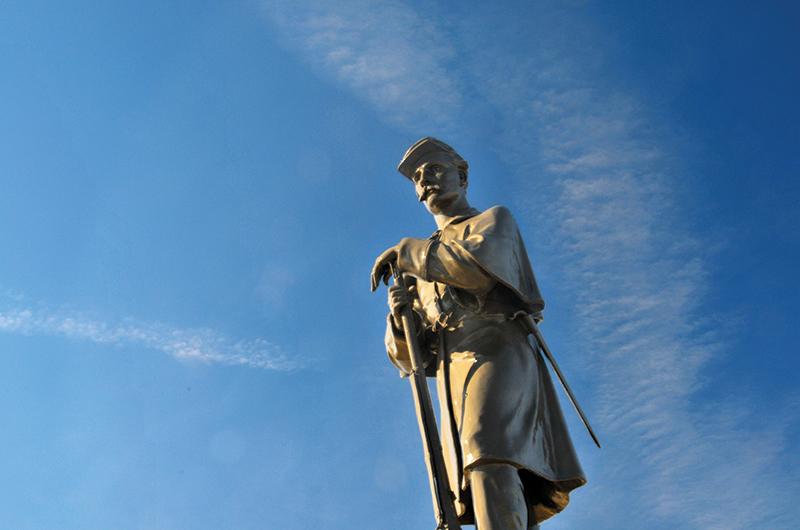
In its day, it was one of scores of statues exactly like it, selected from a foundry catalogue. The soldier, a Union infantryman, stands at parade rest, his hands loosely holding a Springfield musket, the initials “U.S.” plainly inscribed on his belt buckle and cartridge sack. Originally the statue stood at the head of Circuit Avenue in Oak Bluffs, erected there in the summer of 1891 to honor the Grand Army of the Republic, a fraternal organization of Civil War veterans.
All plain enough. How then, over the succeeding decades and all across the Vineyard, did this statue come to be thought of as a Confederate soldier?
The story begins with Charles Strahan, born in Baltimore on November 10, 1840. A Southerner frustrated that his native state had remained in the Union as others seceded, in 1862 he joined the Maryland Guards, a segment of the Confederate army that was later incorporated into the 21st Virginia Regiment. He was wounded by a Union bullet early on, but later served at Gettysburg. Strahan was twenty-five miles away when General Robert E. Lee surrendered in Appomattox Court House, Virginia on April 9, 1865, and he recalled with gratitude the mercy that General Grant had shown the Army of Northern Virginia.
Strahan moved his family to the Vineyard in 1884 and took over the Cottage City Star, an Oak Bluffs newspaper, renaming it the Martha’s Vineyard Herald. Seven years later, he offered to erect a monument to the Grand Army of the Republic in his new hometown, paying for it with every dollar earned from new subscriptions that year. His goal was to help heal the division between North and South, and when the $1,500 raised fell $500 short, he apparently made up the difference out of his own pocket.
Cast in zinc by J.W. Fiske and Company of New York and standing seven feet tall atop a base of cast iron, mounted on Quincy granite, the Soldiers’ Memorial Fountain, as it was formally known, was dedicated before a crowd of hundreds on August 13, 1891. “That this comes from one who once wore gray,” said Strahan, “I trust will add significance to the fact that we are once more a union of Americans, a union which endears with equal honor the citizen of Georgia with the citizen of Maine; that Massachusetts and South Carolina are again brothers; that there is no North nor South, no East nor West, but one undivided, indivisible Union.” Through the crucible of civil war, Strahan had emerged a stronger patriot.
Inscriptions on three sides honored the Grand Army of the Republic as a whole and its Island chapter in particular. After the ceremony, Strahan wrote of his hope that the monument would at last dissipate the “mists of prejudice,” and that veterans of the Union Army might, in turn, offer a tribute to their old foes on the uninscribed side of the monument.
It took several decades, but on September 4, 1925, the remaining few members of the Vineyard post of the Grand Army of the Republic came through. Strahan was eighty-six and frail, but able to attend the unveiling of an inscription on the fourth plaque. “‘The chasm is closed,’” it read. “In memory of the restored Union this tablet is dedicated by Union veterans of the Civil War and patriotic citizens of Martha’s Vineyard in honor of the Confederate soldiers.”
The statue and fountain were moved to their current location across from the Oak Bluffs ferry terminal in 1930. Over succeeding generations, the soldier lost his rifle, scabbard, and a hand, and decay began to eat away at the statue and pedestal. In 1974, while preparing for the American bicentennial, the Oak Bluffs Parks Commission decided to paint the statue gray to emphasize its tie to the former Confederate soldier. Instead, the paint change left behind the Island-wide impression that the statue was a representation – however weirdly out of place – of Johnny Reb himself.
A group of Vineyard volunteers began raising money to restore the memorial in 1998. The statue was sent to Mark Rabinowitz, a conservator who was then based in Brooklyn, who removed twenty-two layers of paint, reconstructed the statue with a new scabbard and rifle cast from authentic pieces owned by the late Bill Nicholson of Oak Bluffs, and recast a hand. At a cost of nearly $80,000, most of it privately raised, the Soldiers’ Memorial Fountain was rededicated on August 17, 2001.
In 1925, Charles Strahan had stood before an assembly of Islanders to thank the few remaining Union Army veterans for finally paying tribute to those who had fought for the South: “I was the first Confederate soldier to honor the Northern people, and the people of Martha’s Vineyard are the first to honor the Confederate soldier,” he said. At the close of his speech, the band played “Dixie,” and it was reported that “a few rebel yells were heard among the general applause.”
The statue remains the only memorial north of the Mason-Dixon Line to soldiers on both sides. Charles Strahan died March 24, 1931, at the age of ninety-one. With members of his family, he is buried in the Oak Grove cemetery in Vineyard Haven.
Sources include the libraries of the Martha’s Vineyard Museum and the Vineyard Gazette; David Wilson of the Soldiers’ Memorial Fountain Restoration Committee; and Dr. William T. Strahan of Silver Spring, Maryland.




